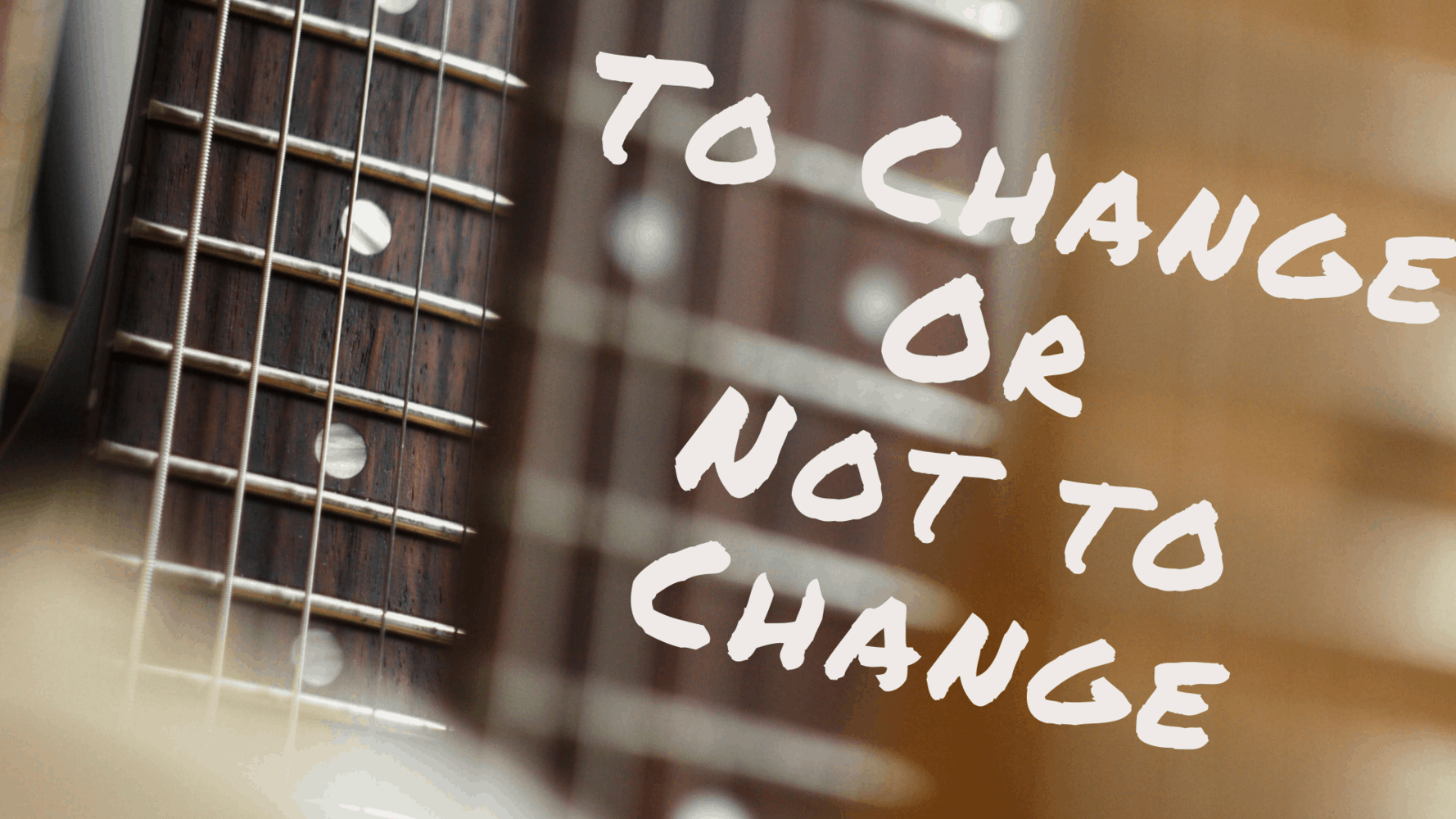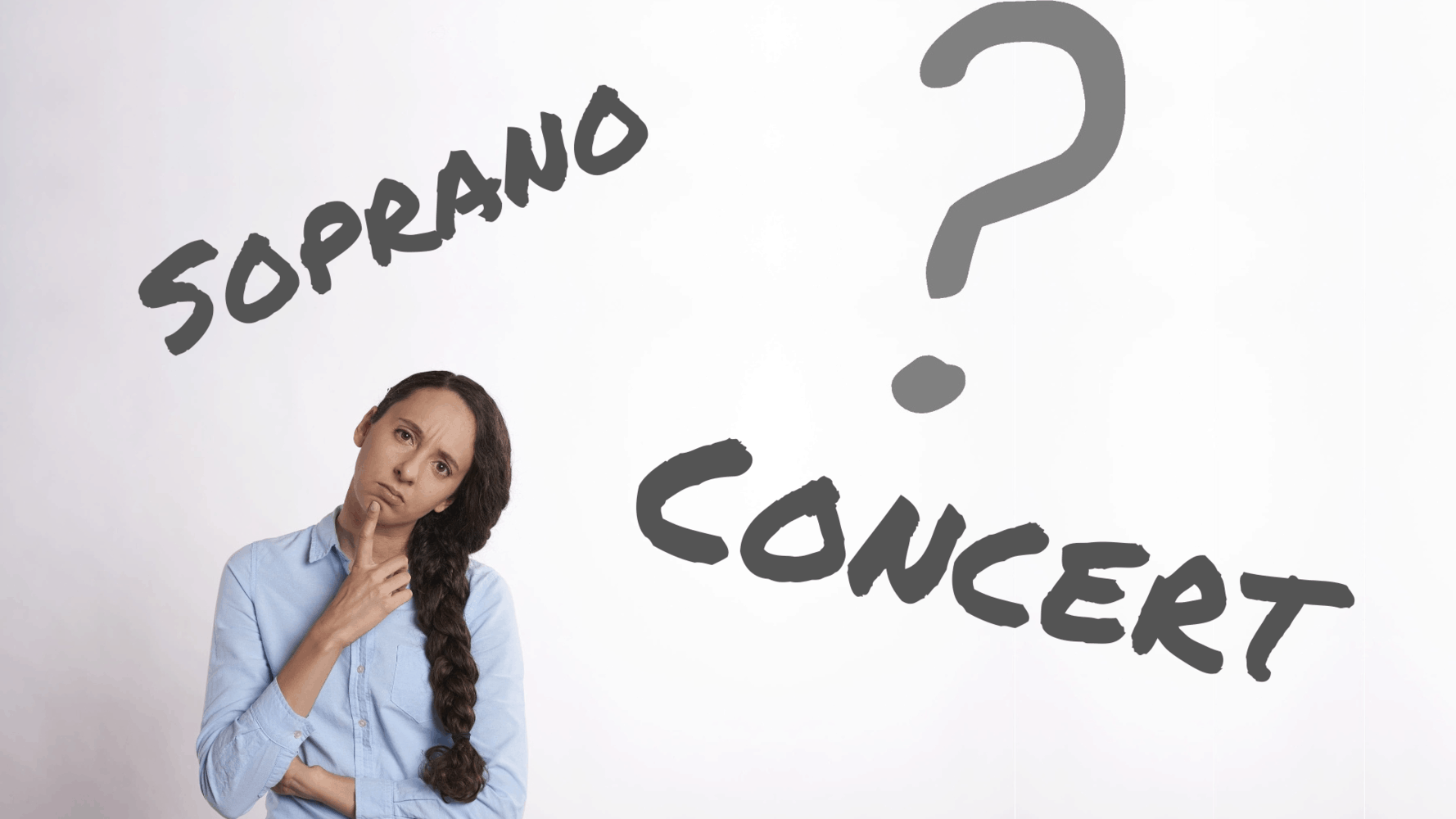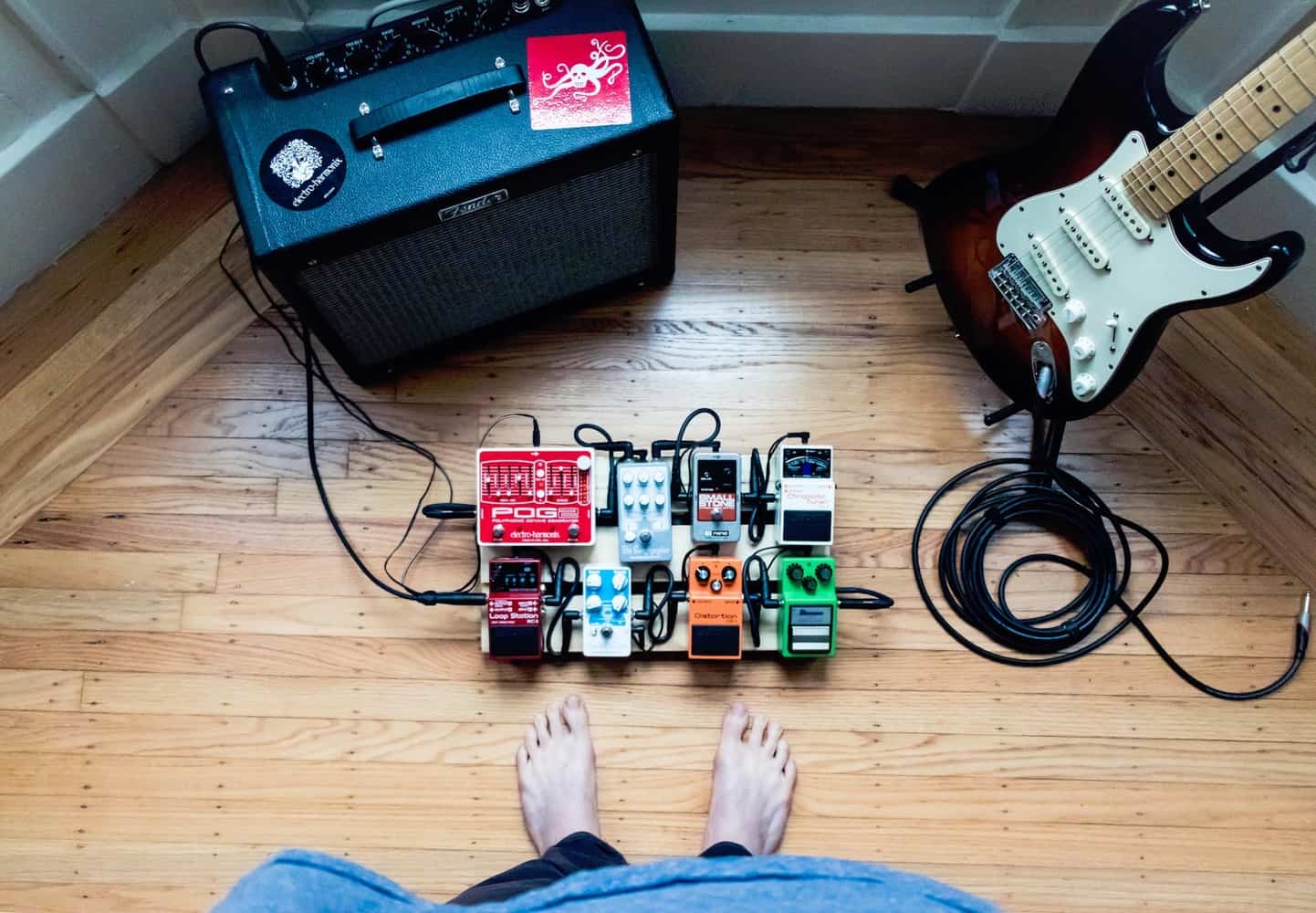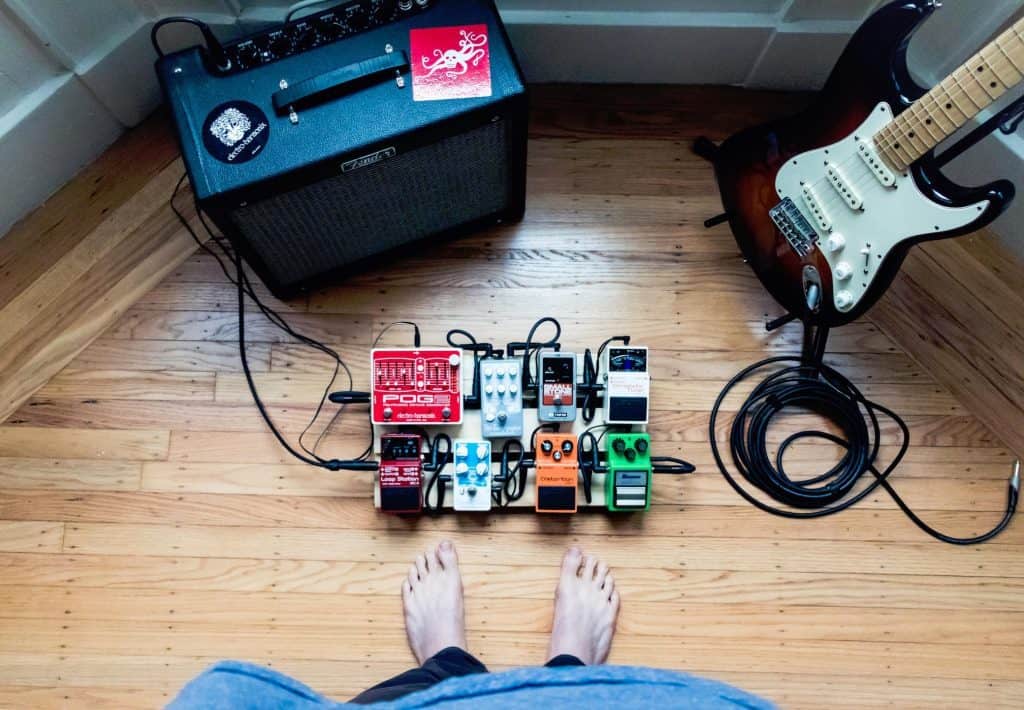
Guitarists love to shape their tone with effects pedals. But once you own more than one or two of these wonderful toys, questions arise. How do I set up my guitar pedals? Which effects do I really need? And, in what order should I connect them up?
It can be frustrating when you know the sound you want but can’t get it. Let’s run down the basics of guitar effects chains and how to set them up for the most useful tones and flexibility.
What pedals should every guitarist have?
The Most Important Pedals
If you’re anything like me, you decided to buy your first pedal when you ran out of tones using just your guitar and amp. Beginners often wonder: what pedal you start with? Now, this may sound dumb, but it should probably be a tuner pedal. Though nowadays, some of the clip-on tuners do a pretty good job.
Beyond that… well, that’s when the fun starts. A good starting point is to get an Overdrive and a decent Reverb or Delay. You can go a long way with this simple rig. If you play a lot of clean tones, say for funk or country, a Chorus and a tasty Reverb may be all the sweetening that you need.
Which Guitar Pedals Should I Start With?
It can be useful to think of guitar effects in four groups.
- Dynamics – Compressors and Volume Pedals
- Gain Pedals – Overdrives & Distortions
- Modulation effects – Phasers, Chorus, Flangers & Vibrato
- Time-based Ambience – Delays & Reverbs
You could play an incredibly diverse mix of styles owning just one good pedal from each of these groups. A full set of effects might look like this.
- Tuner Pedal
- Wah Pedal
- Distortion Pedal
- Overdrive Pedal
- Noise Gate
- Chorus Pedal
- Reverb Pedal
- Delay Pedal
- Volume Pedal
- Specials (more on these later)
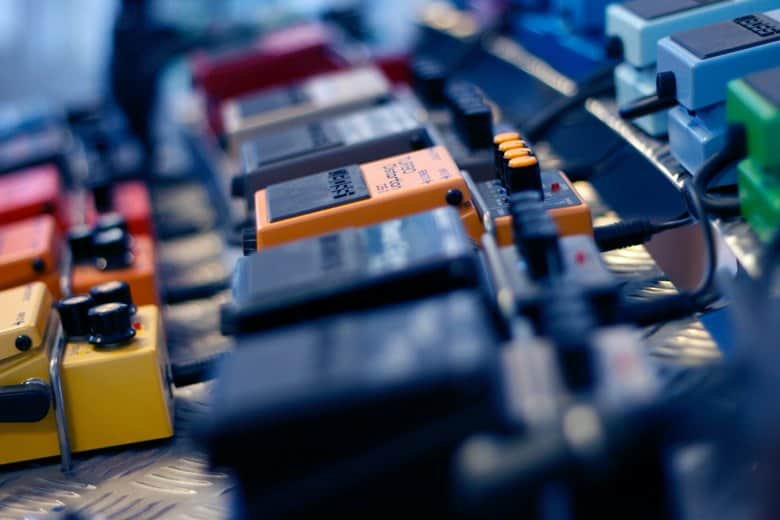
Planning your sound
Before you begin planning your pedal setup, you need to think about what you want to achieve. Most gigging guitarists put together a rig that gives them plenty of versatility. That way, they can play in many different genres, all with the same gear.
Think about what you want from your set up. I always suggest that you start by finding your favorite rhythm guitar texture first.
Nail Your Rhythm Sound First
A great starting point is to decide what will be your main rhythm sound. There are two ways that players create their rhythm guitar tone. From their Amp or from their pedals?
Experiment and plan how you will do it. Will your main tone be the sound of your amp, utilizing your amplifiers preamp gain to shape your sound? Or will you create your core rhythm tones using your gain pedals? Both approaches work. No one way is the best. It’s often a matter of personal preference.
Even if you do decide to go down the amp/preamp route you will still use overdrive and distortion pedals. Only now those units will function more as boosters and tone shapers than as your primary sound. You can kick in overdrive for your lead breaks or distortion for some of the more raucous tunes of the night.
Three essential concepts to understand the best order for your guitar pedals
It is true to say that there is no wrong way to connect your pedals. Your signal chain could be set up in many ways to achieve a wide range of timbres. What works for you and your rig may be different from what works for other players.
Even so, there are still some key principals that almost always apply when you begin to connect up multiple effects pedals. Here are the 3 key principals to remember when s below to guide you when deciding on your pedal board order.
Principal No.1: pedals that boost the volume also add and amplify noise

Pedals, especially gain pedals, introduce extra buzz and hiss. For this reason, these units should generally go nearer to the beginning of the signal path. Here we are talking about the overdrives, the distortion effects, and the compressors. Anything that lifts the level. When placed at the end of the effects chain, theses units boost everything that came before them. They amplify not just your guitar, but also any noise generated by the other pedals in the signal path. But, by placing the gain pedals up front, you maintain control. This will minimize unwanted noise, which can otherwise become bothersome.
Principal No. 2: place the pedals that create your tone before those that modify it

Flangers, vibratos, phasers, and chorus effects are modifiers. They enhance a sound. It’s logical to place them in the chain AFTER the overdrives and distortion pedals. Shape your guitar tone with the gain pedals then add the more subtle modifiers afterward.
Principal No. 3: Any pedals that add ambience go last

Here we’re talking about reverbs and delays. Especially reverbs. Reverb gives your guitar an ambient trail simulating a real physical space, a hall or a room. This embellishment to your sound and is almost always best when added last in the signal chain.
How do you set up a pedalboard
Now that we’ve covered some basic principles, it’s time we got to the crux of the issue. How do we hook them up?
When you’re putting together your pedalboard, there are some “rules of thumb” that will help you.
Rules of Thumb: What order should my guitar pedals be in?
Above we outlined the four groups of guitar effects. Dynamics pedals, Gain Pedals, Modulation effects, and Ambience. We’ll add one more here: The “Specials” Group. As a guiding principle, this is the order that your setup should follow.
Dynamics > Gain > Modulation > Ambience > Specials
The Dynamics Group
This group of pedals are those nearest to the guitar. They are the first to have and affect the volume and punch of the instrument as you play it.
The Wah-Wah sweeps up and down the frequency spectrum as you roll the foot controller. This narrow frequency peak can add a lot of level to the signal. Compressors, at this point, help to control the dynamics of everything that follows.
- Wah-wah pedal
- Auto-wah or other types of filter effects
- Compressors
- Octavers or Pitch Shifters
- EQ Pedal
- Volume Pedal

Typical units found in the Dynamics group
The EQ pedal is interesting. It can fit into a few different spots in the signal chain, depending on what you are trying to achieve. It is often placed within the Dynamics group as a booster for solos or standout passages. The Volume pedal can appear either in this group, at the “guitar end,” But it can also be useful at the “amplifier end.” We’ll come back to this later and discuss which position may suit you best.
Gain Pedal Group
Now we come to the gain group. Here you will forge the shape of your sound. Use this section to add some crunch and grit to add personality with an overdrive. For those more aggressive tunes, add a more full-throated hard-driving distortion pedal.
Typical units found in Gain Pedal Group
- Fuzz
- Distortion
- Overdrive
Although it isn’t strictly a part of this group, some players will place a Noise Gate at the end of the gain group. The gate is especially important if you play metal or hard rock and use a mountain of gain. A Noise gate placed here can be incredibly helpful. It will manage the hiss and buzz generated by some of those more heavily distorted tones.
Overdrive & Distortion together
Many, if not most, players have more than one of these gain options in their rig. There is a trick here. To get the best results with two units turned on at the same time always place the most ferocious pedal first. The Distortion goes before the Overdrive. You get the boost, aggression, and sustain from the distortion pedal. Then you layer the less aggressive overdrive tones on top of it to add personality to your sound.
The Modulation effects Group
Modulation effects are terrific to give your sound breadth and subtle movement. Van Halen, Queen, U2, the Police, and many other classic bands relied on these units to add a sweet sheen to their sound. Modulation adds a terrific depth to the sound of a crunchy or distorted guitar.
Typical Modulation effects
- Chorus
- Leslie
- Flanger
- Phaser
- Vibe
- Vibrato and Tremolo
These “time-based” modulation effects are used one at a time, so the order within the group is not essential. If you ever do switch two units on together, the result in a confused mess. But hey, that might be what you’re going for!
The Ambience Group
This group adds space and atmosphere to the sound that you’ve crafted in the preceding groups. Other than for occasional special effects, these effects are usually used sparingly. They’re often left switched on all the time and adjusted to fill out the sound but not so loud that they swamp it. It is equally valid to leave them turned off and then just kick them in when you want reverb or delay for solos.
Typical members of the Ambience group
- Delay
- Echo
- Reverb
As a rule, Reverb is usually the last pedal in the signal chain before the sound goes to the amplifier. It adds a simulation of physical space, a room, or hall. It provides a sense of size, depth, and fullness to your sound.
It is fine to use delay and reverb at the same time. But if you do, its generally wise to keep the delay level slightly lower.
The Specials Group
The last group to discuss is the “specials.” They come last in the chain immediately before your signal goes into the amplifier. There are two types of effects commonly found in this spot. They are the Loopers and the Boosters.
Loopers
I idea of looping has come a long way since it was first pioneered in the 1960s using tape machines. Today looping is commonplace. It is also one of the most creative spaces in your setup. Guitarists continue to find new and exciting ways to use loopers.
Boosters
Boosters serve a deceptively simple purpose. Just press the footswitch, and you get louder. (These should not be confused with ”Treble” Boosters which are the same – but different)
History of the Booster
The need for boosters arose in the late ’60s for entirely practical reasons. Musical tastes were changing. The sound of a loud guitar played through an overdriven amp had become fashionable.
Amp manufacturers had carefully designed their amplifiers so that they did NOT distort. Yet, guitarists wanted to drive their amplifiers hard. They wanted the valves in the amps to clip. The resulting harmonics were pleasant and desirable. Distortion, in this case, was good!
This was the reason the booster was born. It lifts the signal from the electric guitar up high enough to drive the amp input valves into distortion.
Boosters today
Today Boosters are used for precisely the same thing. To lift up the guitar level.
Nowadays, of course, amplifier designs have evolved. Most modern amps no longer need a booster to achieve that driven sound. . Nevertheless, boosters are incredibly handy to fine-tune the way you drive the input of your amp. They are often set up to provide 3 or 4dB of extra gain for soloing. When used for solo boosting they are better placed just before the gain group.
Departures from the norm and variations on the theme
Of course, none of this is set in stone. You can experiment and find what works best for you.
Some ideas to try out
Try out different places to hook in your compressor. Try it after the gain group, before the ambiance pedals. This can provide a slightly different “feel” for your playing that you may enjoy. This compressor placement is something David Gilmour is known to do.
Investigate what happens if you move the Wah-Wah after the gain group. Keep the overdrive settings subtle. Carlos Santana does precisely this. He drives his wah from the output of a smooth overdrive pedal. Tasteful.
You might also like to try out the sound of a chorus pedal inserted before the distortion effects. Then move the pedal after the distortion and check out the difference. Experiment. Find what you like that is unique and yours.
Guitar Pedal Effects Troubleshooting
To wrap up, here are a few tips to help you when things go wrong.
My Pedals Won’t Work – Basic Checks
1/ Check the Pedal settings
- If you have a volume pedal – is it turned up?
- Check the setting on every pedal that has a gain or output level knob. Are the outputs turned up?
(Oh yeah – check that the volume knob on the guitar is turned up too)
2/ Check the power
- If it has a battery, is the battery charged?
- If you are using a power supply, is it plugged in and turned on? (I know – I know – but I had to say it!)
- Is it the correct power supply
- Check that the voltage is correct and matches the requirements of the pedal.
- Check the polarity (+ and – around the right way)
- Are you running too many pedals off of a single power supply? Try running one pedal at a time.
3/ Check the cabling
- Are all the plugs pushed all the way in and firmly seated.
- Have you got the “in” and “out” the correct way around (I know – I know)
- Are the cables the correct type. Stereo cable got in there by mistake? (TRS or TS)
Still won’t go – Isolate and test
If you’ve checked the basics and you still can’t get your rig to work, then you need to start isolating the individual components.
Bypass the pedalboard entirely and plug the guitar directly into the amp.
If you DON”t get any sound now, then the problem is the guitar, the cable, or the amp.
But if you DO get music, the issue is in the pedals.
Check the pedals one at a time to figure out which one is the problem.
Some Common Questions
What is a volume pedal used for?
Volume pedals typically go at the beginning of the signal chain. They allow you to have control over the level of the signal feeding into the gain pedal group. You have control over how much “drive” the gain pedals get. What this means is that you can achieve a variety of overdrive and distortion tones.
However… the Volume pedal can also be inserted at the end of the chain. Generally, this would be directly before the reverbs and delays. When placed here, the volume pedal will affect your total volume but not the sound of the gain pedals. Both approaches have merit. Try them and decide which suits you the best.
Where does the EQ pedal go in the chain?
The EQ pedal is another unit that can be inserted into a few different spots in the chain. Most often, it goes straight after the gain group before the modulation effects. It is adjusted to fine-tune your tone. EQ’s are commonly used as a mid-booster. You switch it on when you need some extra cut for your lead breaks or a bit more bite for a particular song of passage.
Should chorus go before or after delay?
Chorus almost always comes before the delays. You should consider the chorus as part of your guitar tone. The delays and reverbs provide a sense of space around your tone. But remember – there are no rules. As always, experiment.
What does a fuzz pedal do?
Fuzz is a type of gain pedal. In fact, fuzz pedals were the very first type of “distortion” pedals ever designed. Their distinctive square wave clipping type tortured tone is brazen and brutal.
Fuzz is more aggressive than overdrive and less controlled than distortion. By way of explanation: Overdrive pedals mimic the sound of a valve guitar amp input driven hard. Distortion pedals give a harder, more aggressive sound reminiscent of a large valve amp and speaker stack.
Fuzz, on the other hand, isn’t mimicking anything. It is, as they say, its own thing. In fact, fuzz is the sound of a transistor being abused! The transistor circuit clips the signal and adds raw harmonics to your guitar tone. Many guitarists utilize all three types of gain pedals on their floorboards.

